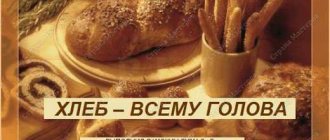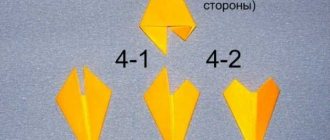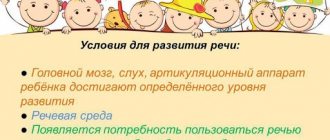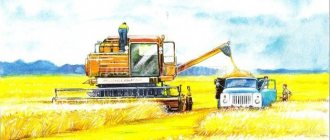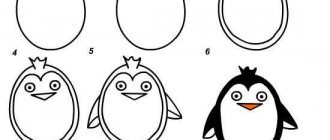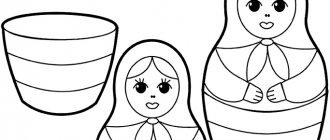History of bread for children
What was the first bread?
Each product has its own history. Such a universal product as bread exists in almost all countries of the world. Bread has come a long, complex way before it takes the form of beautiful loaves on our table.
15 thousand years ago
Our ancestors, in search of food, came across
cereal plants.
Ancient people simply collected grains and ate them raw. Later, they learned to grind the grains between stones, pour water into the resulting mass, reminiscent of flour, and cook it. So we can say with confidence that the first bread was a nutritious mushy mass of flour and water. People realized that porridge made from roasted grains tasted better and began to make it thicker and bake it. The first unleavened bread cakes were produced - the world history of bread baking begins with them. During these times, the first ovens, dishes, mortars for grinding grains, and mills with millstones were created.
Fluke
Lush bread did not appear immediately; it happened about 5
thousand years ago
.
According to legend, one of the slaves in ancient Egypt
forgot about the dough, and it fermented a little. He couldn’t leave his owners without bread, so he still put the dough in the oven. Everyone was surprised by the appetizing appearance and wonderful taste of the new loaf. It retained freshness longer and was better absorbed by the body. Instead of punishment, the slave was asked to tell what he did to make the bread so soft and rosy. Having broken the bread, the ancient people saw that it was full of small holes inside; this was air that appeared during the fermentation process.
In Russia in the 11th century
Sour rye bread was baked using sourdough from previous baking. The sourdough recipe has been passed down from generation to generation.
Yeast did not exist in its pure form, so instead, fermented grape juice, beer foam, leaven made from flour and wine were mixed into the dough, or the dough was simply left for a long time so that it would rise on its own. In Rome and Greece, bread made from slightly fermented dough
considered food for rich people, it was served as a separate dish. The slaves had to be content with coarse bread; the dough for it was not fermented, but baked immediately. Different variations of bread appeared - with milk, sugar, poppy seeds, honey.
The first bakers and automation
The ability to bake delicious, fluffy bread was highly valued in those days, so bakers were cherished. For the murder of a baker, a man was immediately executed,
after all, it could provoke famine. But if the baker himself made bad bread, he was punished to the fullest extent, because people obtained flour with great difficulty, and it was impossible to transfer it to unsuccessful baking. And recipes for good bread were kept secret. Bakers and their students over time developed certain recipes, norms and rules for baking bread.
By the 19th century
the process of growing wheat, harvesting, milling and baking
was automated.
And of course, now we cannot fully understand how difficult it was for our ancestors to get bread. Now making homemade bread will not be difficult.
Bread as the basis of life
For Russians, bread is more than just a food product; it is part of their cultural heritage
.
There are many traditions where bread plays a big role; remember even the tradition of meeting honored guests with “bread and salt”, a loaf for newlyweds.
Bread is treated with reverence and children are taught this.
It is unlikely that people will ever stop eating bread. Bread production will never lose its relevance.
No matter what form bread appears before us - flatbread, loaf or baguette, it remains the connecting link of all countries of the world. Bread is a symbol of hard work and well-being created with your own hands.
“Bread is the head of everything” - how to spell it: punctuation marks
“Bread is the head of everything”
In another article on our website, read about the meaning of another famous proverb “The world is sanctified by the sun, and man by knowledge .
In Rus', people were always greeted with bread and salt. The loaf was considered a symbol of an easy and harmonious family life. Therefore, for our people this is not just a product, but a real element of culture. How is the saying “Bread is the head of everything” written? What punctuation marks are used?
There are 2 approaches when writing this expression:
- Some people believe that it is necessary to put a dash, since between the words “bread” and “everything” you can insert the word “this” : “Bread is the head of everything .
- But there is also a radically different opinion. Since the predicate is preceded by an inconsistent secondary member of the sentence related to it (the word “to everything” ), a dash is not placed. Accordingly, . ”
The second option is considered correct. You can see this with examples:
- Just as bread is the head of everything in the world of people, so the ISO/OSI model is the head in the world of networks (A. Vatamanyuk, book “Home and office networks under Vista and XP, 2008”).
- Due to its unconditional nutritional value, we have forgotten the old Russian proverb “Bread is the head of everything!”
- Never throw a piece of bread on the ground. It’s not without reason that they say: “bread is the head of everything!” . If you don’t want to eat, it’s better to just give it to a homeless animal.
However, it is impossible to say that the writing “Bread is the head of everything” is inappropriate. These 2 options are used quite widely in the written version of the Russian language.
The path from grain to loaf of bread
Bread has a special place in our diet. Without bread, nutrition for both healthy people and those who need food is unimaginable. Moreover, bread has a rather rare property as a food - it never becomes boring, which allows you to include it in your diet every day.
Bread is an important and affordable source of valuable vegetable protein, which contains a number of essential amino acids (methionine, lysine). Wheat bread contains more protein than rye bread (8.6 and 5.6%).
Bread is especially rich in carbohydrates (rye 40 - 43%, wheat 42 - 52%), contains little fat - from 0.6 to 2.9%.
Bread is an important source of B vitamins. It serves as a daily supplier of plant fiber. Finally, bread is a source of minerals the body needs, namely potassium, calcium, magnesium, sodium, phosphorus and iron.
Bread is not easy to reach our table. A loaf of bread begins with grain. It takes 1200 grains to bake one loaf of bread. And for a small grain to become bread, three forces are needed: earth, sun, work. Bread is the work of thousands and thousands of hands.
His journey begins in early spring, when cars drive up to the fields. Those who drive a car have a lot of work: They need to plow the field, loosen the soil - quickly prepare it for sowing. They say: “ Spring is the food for the year.” After some time, other machines are working in the field. Seeders are used to quickly sow huge fields.
Before sowing wheat, the grain is checked for germination. They are sorted on special machines called sorting machines. For sowing you need medium, normal grains. All grains in spring and winter. Grains are sown in the spring and harvested in the fall. Winter crops are sown in August-September and harvested in June-July; they bring a large harvest.
Grains sprout in the field and shoots appear. In summer the whole field is a mess.
When autumn comes, the ears of the corn turn golden. The bread is ripe. It's time to harvest. And again the cars entered the field. These are combines.
And then the grain is delivered by car to the elevator, where it is protected from cold, moisture and harmful insects.
Then the grain is sent to grain mills, and from there the flour goes to bakeries and confectionery shops.
From the bakery, the finished bread is delivered to the stores in special vehicles.
And from stores, bread comes to our table in the form of a huge assortment of bakery products (more than 100 types of bread, cookies, muffins, buns, pies, birthday cakes, crackers, etc.).
The path from grain to loaf of bread is shown in the figure in Appendix 1.
“Bread is the head of everything” - who said: the origin of the saying
“Bread is the head of everything”
It’s always interesting who came up with this or that proverb. Who said “Bread is the head of everything” ? What is the origin of the saying?
- This is an old Russian proverb invented by the people.
- Bread has long been the basis of food in peasant families. They not only ate it, but also made kvass and alcoholic drinks from it.
- Also, do not forget about the role of bread in various kinds of “rituals”: for example, when welcoming guests, at a wedding.
Moreover, in the absence of technology, in ancient times, people got their bread through very hard work. That is why he was so revered.
Severe necessity
Before the blockade began, a terrible thing happened: German aircraft raided the Leningrad Badayev warehouses. 23 German bombers placed the bombs so accurately that over 3 thousand tons of flour burned out overnight. Most likely, they were sent to warehouses. The city was surrounded, there was nowhere to get food from. Cards have been introduced in Leningrad since July 18. And from September 8 - the actual beginning of the blockade - the bread portion began to systematically decrease.
There were five reductions in total, and from 800 grams in July, the portion fell to 200 grams of bread for workers and 125 grams for everyone else. Now it’s difficult for us to understand, but you may remember one of the cut edges of black bread that you were given at school for lunch, it’s even a little more than 125 grams. But was it similar to our modern bread?
Conversation with children and preschoolers on the topic “Bread is the head of everything”: arguments
“Bread is the head of everything”
In schools and kindergartens, teachers and educators conduct open lessons on this topic. They tell children how valuable bread is, and the kids learn and read poems about it, and write stories. Here is a conversation with children and preschoolers for such a lesson on the topic “Bread is the head of everything” with arguments:
Guys, why do you think that bread is the boss of everything? Not just because people like the taste.
In fact, the bread we eat every day is the result of hard human labor. You all love cakes, cookies, buns, pies. Do you know what they are made of? That's right, made from flour! But for a spikelet to become a bun or loaf, it needs to go a long way.
Did you know:
- Once upon a time, primitive people noticed that the seeds of wild plants sprout in the ground. They liked the taste of these seeds.
- Subsequently, they began to be sown in the ground. This activity became the origin of agriculture.
- As for flour, it appeared as a result of human pressure of seeds.
- The first bread was baked over a fire.
- Then wooden plows and domestic animals appeared, thanks to which people plowed the land.
Now there is a lot of agricultural equipment that is involved in the production of bread: seeders, combines, tractors. The ears are threshed, the grain is cleaned, loaded, stacked, and dried. This is a very painstaking process that involves thousands of people.
That is why this poem about bread arose:
Verse about bread
Previously, when our grandparents were not in the world, bread was called “zhito” from the word “to live.” If the bread fell out of their hands, they did not throw it away, but shook it off and ate it. Even dropping a crumb on the floor was unforgivable. This speaks of the great love of the Russian people for this product. Bread may not be a complete meal, but if it is available, it means that life is not so bad.
People used bread both in everyday life and at celebrations. It was believed that a person could survive if he had bread at home. Along with bread, people had great respect for water. Both are symbols of life.
Getting bread is very difficult:
- First, the grains are sown in the ground.
- Then they sprout, drink rainwater and begin to reach for the light.
- Then, as the summer passes, the spikelets grow.
- The grain ripens in the fall. And when the spikelet turns golden, the harvest is harvested.
- Harvesters cut the ears, load them onto a machine, and transport them to the mill. It turns out flour.
- Then the finished product is transported to special enterprises. Wheat flour produces white bread, and rye flour produces black bread.
- When the bread is baked, you still need to distribute it throughout the city so that it is in stores, schools, and kindergartens.
By the way, children, do you know how dear guests have always been greeted in Russia? Bread and salt! It was a sign of respect, a sign of hospitality.
In all centuries, bread has been considered a sacred product. This is a kind of amulet aimed at well-being. Therefore, you and I must respect the work of other people and value bread. However, other products should also be treated with respect. Because in the old days (for example, during the war) people suffered from hunger and could not afford what we can now.
“A piece of siege bread is like the only source of life and hope. Bitter bread of war"
Donskaya N S
“A piece of siege bread is like the only source of life and hope. Bitter bread of war"
Extracurricular event in 2nd grade on the topic: “ A piece of siege bread as the only source of life and hope . The bitter bread of war ."
Prepared by: primary school teacher: Donskaya N.S.
Topic: “ A piece of siege bread as the only source of life and hope . The bitter bread of war ."
Goal: to cultivate students’ patriotic feelings, their civic and spiritual education using the example of specific people and their actions;
expand students' knowledge about the Second World War;
cultivate a caring attitude towards bread .
- increase interest in reading; develop oral and written speech;
- introduce students to the life of people during the siege of Leningrad , with their heroic deeds; with the concepts: “klibanos”
,
“elevator”
,
“
blockade ” ;
“
siege bread ” ,
“ration”
;
with proverbs about bread .
- cultivate a sense of compassion and empathy, the desire to do good and resist evil; cultivate respect for older people; careful attitude to bread and love for the homeland .
Technical equipment: computer, interactive whiteboard, speakers.
phonogram of the song “Russian Field”, Gorodnitsky’s song “Black Bread ”; phonogram of Levititan
Additional material: presentation; student training scales; 125 gram piece of black bread ; cards with proverbs, mini-essay templates ; drawings by students; book exhibition with works by writers: Andrei Platonov “Dry Bread ”
, Viktor Dragunsky
“Watermelon Lane”
, Sergei Alekseev
“Festive Lunch”
.
